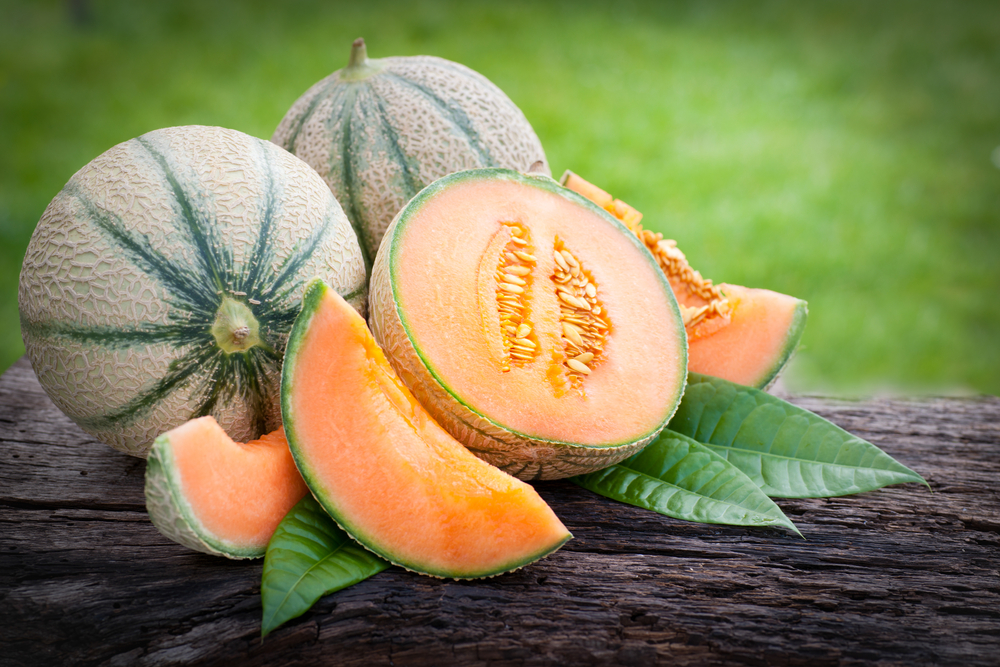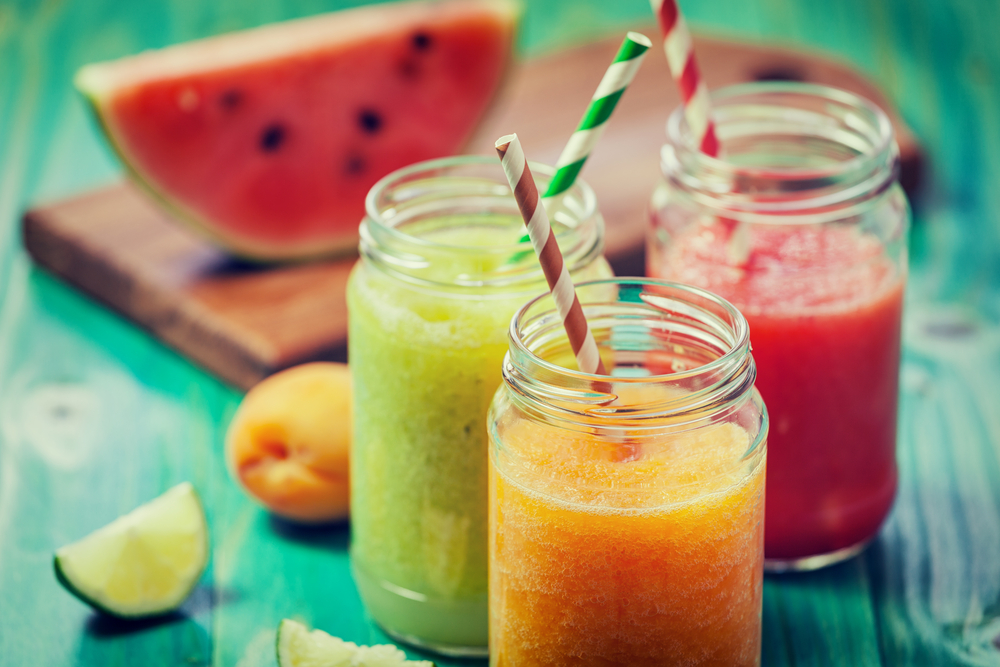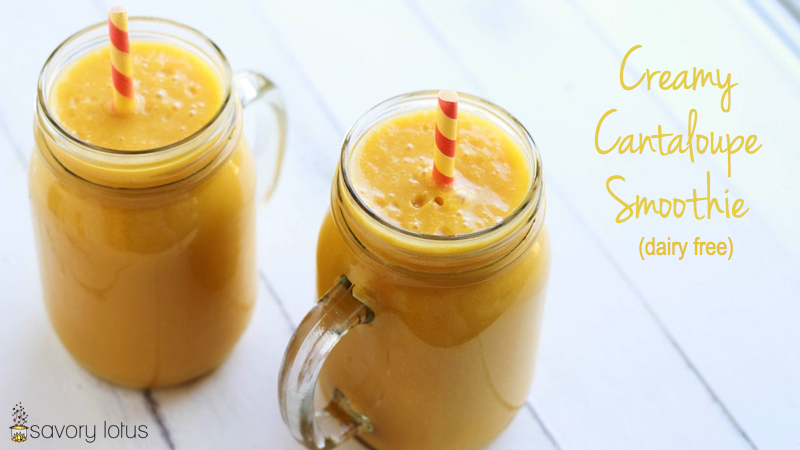Stop Googling Cantaloupe Calories and Make a Damn Melon Smoothie Already

In the summer months, we all start watching our figures a bit more, but this search might be a bit extreme: according to Google Keyword Planner, during the summer months, up to 14,800 monthly queries are made for “calories in cantaloupe.” So let’s set the record straight: even if you eat one entire cantaloupe melon, that’s just 186 calories, about the same amount as half of an avocado. But that’s beside the point — it’s time to stop asking the wrong questions and start asking the right ones (and the right ones have nothing to do with cantaloupe calories).
While calorie-counting has been a popular way to keep weight in check for years, studies now show that it’s not the amount of calories you eat, but the kinds of calories that you eat, that are most important.
The long propagated myth of “a calorie is a calorie” is just no longer true. The differences between fructose and glucose, for example, are enormous: one study showed that these two seemingly similar sugars actually have vastly different effects on appetite due to their effects on the brain. And a 2002 study in the Journal of the American College of Nutrition showed that weight loss is increased 100 percent in a high-protein diet as opposed to a high-carbohydrate diet. In these cases — as in others — the kinds of calories that are being consumed have more of an effect on overall weight loss than calorie counting on its own.
If Cantaloupe Calories Aren’t Important, then What Is?
Given that calories are quantitative, it’s easy to count and keep track of them. When you lose that, what can you rely on?
Basically, whatever you can find at the edges of the grocery store.
Building a diet around whole foods like fruits, vegetables, meats, grains, and dairies is a great way to start. Choosing organic and GMO-free options is even better. And adding a few superfoods in? You’re on the right track for health.
Cantaloupe Nutrition and Benefits
So let’s not talk about cantaloupe calories. Instead, let’s take a look at all the fantastic benefits that this summertime fruit can offer.
Just one cup of cantaloupe contains:
- 78 percent DV of vitamin C
- 30 percent DV of vitamin A
- 12 percent DV of potassium
- (oh, and not that you were worried about it… but only 54 calories)
1. Cantaloupe is great for your eyes.
Cantaloupe’s orange color is indicative of its beta-carotene content. Researchers who studied the beta-carotene content of six different varieties of cantaloupe recently found that they can contain up to 3,138 micrograms of beta-carotene for 100 grams of fruit.
Beta-carotene is converted into vitamin A in the body, which is essential for eye health. And while cantaloupe doesn’t contain nearly the beta-carotene contained in carrots, for example, including cantaloupe in your diet is a great start.
2. Cantaloupe can improve asthma symptoms.
The beta-carotene in cantaloupe isn’t just good for your eyes — it’s also good for your breathing.
A 2004 study in the Journal of Allergy and Clinical Immunology found that increasing consumption of beta-carotene improved quality of life for asthma sufferers.
3. Cantaloupe can lower risk of metabolic syndrome.
A 2006 study of hundreds of Iranian women showed that the risk for metabolic syndrome was inversely proportional to fruit intake, with cantaloupe being one of the top five fruits consumed by these women.
This study also showed that the women who consumed the most fruit had the healthiest levels of C-reactive protein, an indicator to assess levels of inflammation, which was likely instrumental in lowering their risk of metabolic syndrome.
4. Cantaloupe can help prevent chronic diseases.
… especially if you eat the seeds. Cantaloupe seeds contain alpha-linoleic acid, an omega-3 fatty acid that contributes to reduced risk of inflammation and chronic diseases including heart disease and arthritis.
While cantaloupe seeds aren’t commonly consumed, they’re actually completely edible, and they can even be roasted, much like squash seeds.
5. Cantaloupe may reduce diabetes-related problems.
While some people at risk for diabetes avoid fruit, certain fruits can actually be helpful. A 2005 study in BioFactors showed that cantaloupe’s phytonutrients reduce oxidative stress in the kidneys and improve insulin resistance.
Consuming cantaloupe can also improve insulin and blood sugar metabolism, according to some studies performed with rats and mice.
How to Pick Cantaloupe: Our Top 3 Tips
First of all, let’s get one thing straight: when you pick cantaloupe in the grocery store, you’re probably actually buying muskmelon.

Muskmelon image via Shutterstock
Muskmelon is the true name for what we in the U.S. commonly refer to as cantaloupe. Known also as North American cantaloupe or Cucumis melo reticulatus, the melon is characterized by the net-like appearance of the skin.

Cantaloupe image via Shutterstock
A true cantaloupe, also known as a European cantaloupe or Cucumis melo cantalupensis, has ribbed skin and tends to be quite a bit smaller than a muskmelon.
The good news is that both varieties boast the same health benefits, and no matter which variety you’re buying, picking a good one comes down to a few basic questions.
1. How does it smell?
A ripe cantaloupe will smell sweet and quite musky — thus the name muskmelon. Sniff the blossom end of the cantaloupe to see if it gives off a smell. If it smells slightly sweet and perfumed, it’s ripe. If it smells sort of grassy or has no smell at all, it’s underripe. If it smells overly sweet and too strong, it’s probably overripe.
2. How does it feel?
A ripe cantaloupe should be heavy for its size. It should have a firm skin with no soft spots, and if you press gently on the stem end of a ripe cantaloupe, where the vine was attached, it should give way very slightly. If it is soft, the cantaloupe is overripe, and if it is too firm, it is underripe.
3. How does it sound?
A cantaloupe should pass the “thump” test: tap on the cantaloupe gently with your fist; if the sound is dull and deep, it is probably ripe, but if it sounds hollow, it is likely underripe.
Once you’ve selected your cantaloupe, keep in the crisper bin of the refrigerator until ready to use, but no longer than about five days.
Forget the Calories in Cantaloupe and Enjoy These 5 Cantaloupe Smoothie Recipes (and Two Little Extras)
Cantaloupe is delicious plain or served with a dollop of cottage cheese, but one of our favorite ways to enjoy this summer fruit is in a smoothie. Here are just a few of our favorite cantaloupe smoothie recipes.

Melon smoothie image via Shutterstock
1. Three-Melon Smoothie
Cantaloupe pairs well with other melons in this smoothie, which combines cantaloupe, honeydew, and watermelon. This super-hydrating combo gets a bit of sweetness and creaminess with the addition of fat-free vanilla frozen yogurt.

Image care of Green Blender
2. Ginger Cantaloupe Cleanse Smoothie
This tasty ginger and cantaloupe smoothie is great for improving digestion: flaxseed and ginger are combined with cantaloupe and pear for a sweet smoothie that’s easy on the stomach and delicious to sip.

Image care of Green Blender
3. Cucumber Cantaloupe Smoothie
Cucumber and cantaloupe are actually distant cousins, both members of the Cucurbitaceae family. But that’s not the only thing that these ingredients have in common: they’re also filled with water, helping to keep you hydrated as you eat — or drink. This smoothie pairs cucumber and cantaloupe along with spinach, lime juice, hemp seeds, and mint, for a hydrating smoothie perfect for hot days or for right after a workout.

Image care of Savory Lotus
4. Creamy, Dairy-Free Cantaloupe Smoothie
This cantaloupe smoothie gets its creaminess from coconut milk, which lends a tropical flavor to the drink. Cantaloupe is joined by banana and peach for a fruity smoothie with a bright color and a delicious taste.

Image care of Design, Eat, Repeat
5. Peach Cantaloupe Smoothie
This tasty smoothie uses peach yogurt to reinforce the peach flavor of the fruit. A touch of honey and a bit of orange juice add even more sweetness and a bit of complexity to the smoothie. Use already frozen peaches, or freeze your own peaches ahead of time so that you can enjoy this treat.

Image care of Foodness Gracious
6. Cantaloupe Agua Fresca
Cantaloupe may be delicious in a smoothie, but it’s also quite refreshing in this agua fresca recipe, which pairs it with kiwi for a hydrating beverage you’ll sip all season long.

Image care of The Kitchen McCabe
7. Cantaloupe Sorbet
What is sorbet, if not a frozen smoothie? This cantaloupe sorbet, in any case, is a healthful treat that doesn’t contain too much sugar (and you can always leave some out if your cantaloupe is particularly ripe).
Did we miss your favorite cantaloupe smoothie recipe? Let us know! Share your recipes via Facebook or Twitter.
Related on Organic Authority
How to Add Potassium-Rich Foods to Every Meal
An Early Autumn Savory Fruit Salad Recipe
13 Motivating Juice and Smoothie Accessories: Blend, Press, and Chug in Style
Melon smoothie image via Shutterstock

